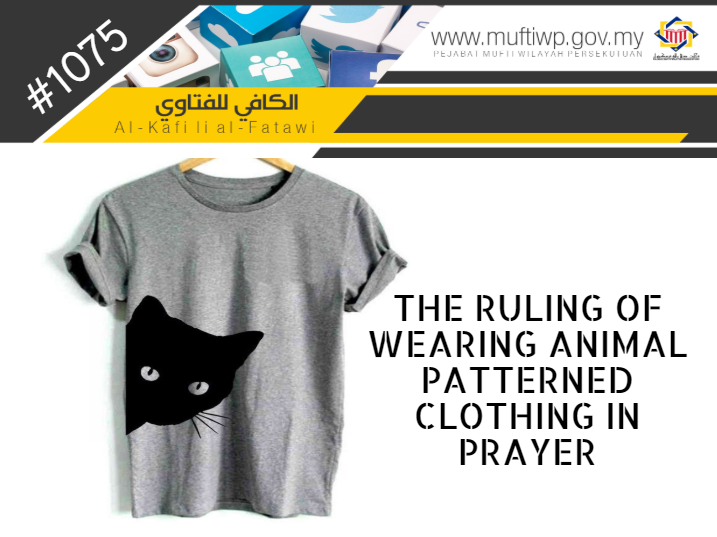Question:
Assalamualaikum SS Dato Seri Mufti. What is the ruling of wearing clothing with pictures of animals in prayer? There are some of the congregation who came to the mosque wearing such clothing. Hope to get an explanation and advise from SS Dato’ Seri Mufti. Thank you.
Answer:
Alhamdulillah, praise and thanks to Allah for the countless blessings He has blessed us all with. Blessings and salutations to the Prophet Muhammad PBUH, his wives, his family, companions and all those that follow his teachings to the day of judgement.
Regarding the above question, it is makruh (undesirable), for it could distract the other praying behind him, looking at the pattern or shape, especially if there are words on it.
In a hadith narrated by Aisyah R.Anha, the Prophet PBUH once prayed with clothing with a picture of a flag or a sign. He then looked at it with sharp eyes and look away saying:
اذْهَبُوا بِخَمِيصَتِي هَذِهِ إِلَى أَبِي جَهْمٍ وَأْتُونِي بِأَنْبِجَانِيَّةِ أَبِي جَهْمٍ فَإِنَّهَا أَلْهَتْنِي آنِفًا عَنْ صَلَاتِي
“Take this garment of mine to Abu Jahm, for it turned my attention just now in my prayer, and bring a simple garment without marks.”
Sunan Abu Daud (4063)
The word “الخَمِيصةُ” means black or red clothing with prints on it. (See al-Mu'jam al-Wasit, 1/256). While the word “أَنْبِجَانِيَّةِ” according to Ibn al-Athir, is read with the letter ba’ with a kasrah and in another narration the ba’ is read with a fathah (anbijaniyyah and anbajaniyyah). It is taken from the name of a place named “أَنْبِجان”. It is a type of plain fur clothing. And it also includes a type of stiff clothing. (See Lisan al-Arab by Ibn Manzur, 2/371)
From Aisyah R.Anha, the Prophet PBUH said:
كُنْتُ أَنْظُرُ إِلَى عَلَمِهَا وَأَنَا فِي الصَّلَاةِ فَأَخَافُ أَنْ تَفْتِنَنِي
“I was looking at its (Khamisa's) marks during the prayers and I was afraid that it may put me in a trial (by taking away my attention).”
Sahih al-Bukhari (373)
There are two opinions from the scholars regarding this issue; the first states that it is makruh (undesirable) while the second opinion prohibits it.
The Opinion that State that it is Makruh
Among the scholars that hold this opinion are:
- Imam al-Nawawi said: “This hadith urges us to always have our hearts present and have khusyuk in prayer by contemplating the meanings of the recitations in prayer. One should avoid looking at things in any shape or form that could distract him.”
- Imam al-Nawawi also said: As for clothing with pictures or anything distracting, then it is makruh to be worn for prayer. (See al-Majmu’ Syarh al-Muhazzab, 3/180)
- Al-Hafiz Ibn Hajar said: Wearing patterned clothing will not affect or invalidate the prayer of someone for the Prophet PBUH did not stop his prayer nor did he repeat his prayer. (See Fath al-Bari, 1//484)
The Opinion Prohibit It
Among the scholars that prohibit it are:
- Ibn Muflih holds the opinion that it is prohibited to wear animal patterned clothing. (See al-Furu’ by Ibn Muflih, 2/18)
- Imam al-Hajjawi said: It is prohibited for a man and woman to wear any animal printed clothing. (See al-Iqna’ fi Fiqh al-Imam Ahmad, 1/92)
- The author of Matalib Uli al-Nuha said: It is prohibited for a man or woman to wear any animal printed clothing. (See Matalib Uli al-Nuha, 1/353)
After analysing the opinion of scholars, we are inclined towards the opinion of Imam al-Nawawi and al-Hafiz Ibn Hajar which state that it is makruh (undesirable). The reason is both wajah intinbat (inference) presented are strong.
However, our advice is one should avoid wearing clothing that has animal pictures or prints while praying in accordance with the clear restriction of the Prophet PBUH in the above hadith.
We would also like to emphasize that the purpose of prayer is to humble oneself to Allah SWT with khusyuk and tawadhuk showcasing our humbleness as His slaves.
In this regard, fiqh scholars state that khusyuk is the soul of prayer. Hence, attaining khusyuk is a symbol of success and happiness. So true is the statement of Allah SWT:
قَدْ أَفْلَحَ الْمُؤْمِنُونَ ﴿١﴾ الَّذِينَ هُمْ فِي صَلَاتِهِمْ خَاشِعُونَ ﴿2
“Certainly” will the believers have succeeded: They who are during their prayer humbly submissive,”
Surah al-Mukminun (1-2)


